Allison Transmission MT4015EN Service Manual
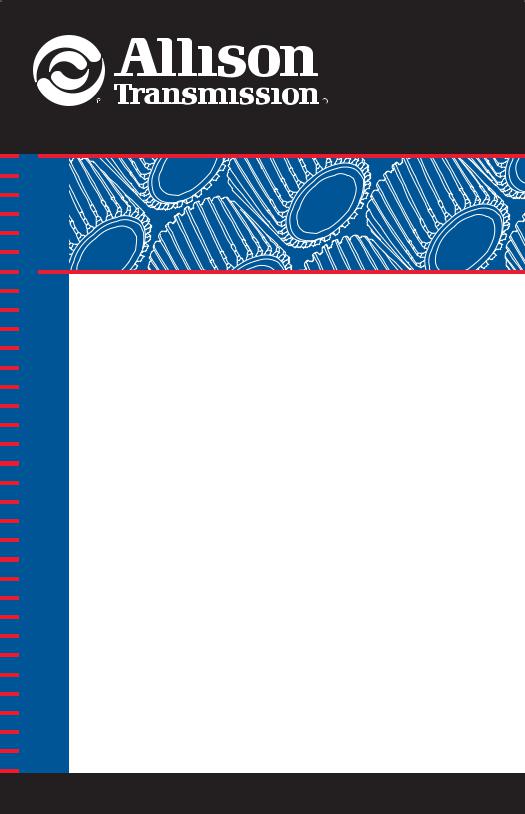
Allison 4th Generation Controls
Mechanic‘s Tips
3000 and 4000 Product Families
MT4015EN

Mechanic’s
Tips
2005 FEBRUARY
Rev. 1 2005 SEPTEMBER
MT4015EN
Allison Transmission
Allison 4th Generation Controls
3000 Product Family (Except 3700 SP)
4000 Product Family
Allison Transmission, Inc.
P.O. Box 894 Indianapolis, Indiana 46206-0894
www.allisontransmission.com
Printed in USA |
Copyright © 2007 Allison Transmission, Inc. |
NOTES
2
|
|
TABLE OF CONTENTS |
|
SECTION I |
INTRODUCTION |
|
|
1–1 |
ABOUT THIS MANUAL . . . . . . . . . . . . . . . . . . . . . . . . . |
. . . . . . 7 |
|
SECTION II |
PREVENTIVE MAINTENANCE |
|
|
2–1 |
PERIODIC INSPECTION AND CARE . . . . . . . . . . . . . . . . . |
. . . . . 18 |
|
2–2 IMPORTANCE OF PROPER TRANSMISSION FLUID LEVEL . . |
. . . . . 19 |
||
2–3 |
TRANSMISSION FLUID CHECK . . . . . . . . . . . . . . . . . . . . . |
. . . . 19 |
|
2–4 |
KEEPING FLUID CLEAN . . . . . . . . . . . . . . . . . . . . . . . . . . |
. . . . 25 |
|
2–5 |
FLUID RECOMMENDATIONS . . . . . . . . . . . . . . . . . . . . . . . |
. . . . 25 |
|
2–6 TRANSMISSION FLUID AND FILTER CHANGE INTERVALS . . |
. . . . 26 |
||
2–7 |
TRANSMISSION FLUID CONTAMINATION . . . . . . . . . . . . . . |
. . . . 30 |
|
2–8 TRANSMISSION FLUID AND FILTER CHANGE PROCEDURE |
. . . . . 31 |
||
2–9 |
FLUID LEAK DIAGNOSIS . . . . . . . . . . . . . . . . . . . . . . . . . |
. . . . 33 |
|
2–10 |
BREATHER . . . . . . . . . . . . . . . . . . . . . . . . . . . . . . . . . . |
. . . . 35 |
|
2–11 |
TROUBLESHOOTING . . . . . . . . . . . . . . . . . . . . . . . . . . . |
. . . . 36 |
|
2–12 |
TRANSMISSION STALL TEST . . . . . . . . . . . . . . . . . . . . . . |
. . . . 42 |
|
SECTION III |
REMOVING TRANSMISSION |
|
|
3–1 |
DRAINING TRANSMISSION . . . . . . . . . . . . . . . . . . . . . . . . |
. . . . 47 |
|
3–2 |
DISCONNECTING CONTROLS . . . . . . . . . . . . . . . . . . . . . . |
. . . . 47 |
|
3–3 UNCOUPLING FROM DRIVELINE, ENGINE, AND VEHICLE . . |
. . . . 49 |
||
3–4 |
REMOVING THE TRANSMISSION . . . . . . . . . . . . . . . . . . . . |
. . . . 50 |
|
3–5 REMOVING OUTPUT FLANGE OR YOKE . . . . . . . . . . . . . . . |
. . . . 50 |
||
SECTION IV |
TRANSMISSION PREPARATION |
|
|
4–1 |
CHECKING INPUT COMPONENTS . . . . . . . . . . . . . . . . . . . |
. . . . 51 |
|
4–2 INSTALLING OUTPUT FLANGE OR YOKE . . . . . . . . . . . . . . |
. . . . 51 |
||
4–3 |
INSTALLING PTO . . . . . . . . . . . . . . . . . . . . . . . . . . . . . . . |
. . . . 52 |
|
4–4 INSTALLING FILL TUBE AND SEAL . . . . . . . . . . . . . . . . . . |
. . . . 52 |
||
4–5 |
CHECKING PLUGS AND OPENINGS . . . . . . . . . . . . . . . . . . |
. . . . 53 |
|
3
SECTION V PREPARING VEHICLE FOR TRANSMISSION INSTALLATION
5–1 |
ENGINE, TRANSMISSION ADAPTATION REQUIREMENTS . . . . . . . |
54 |
|
5–2 |
CHECKING FLEXPLATE DRIVE ASSEMBLY . . . . . . . . . . . . . . . . . |
57 |
|
5–3 |
CHASSIS AND DRIVELINE INSPECTION . . . . . . . . . . . . . . . . . . . |
58 |
|
5–4 |
COOLER, FILTER, AND LINES . . . . . . . . . . . . . . . . . . . . . . . . . . |
59 |
|
5–5 |
CHECKING CONTROLS . . . . . . . . . . . . . . . . . . . . . . . . . . . . . . |
60 |
|
SECTION VI |
INSTALLING TRANSMISSION INTO VEHICLE |
|
|
6–1 |
HANDLING . . . . . . . . . . . . . . . . . . . . . . . . . . . . . . . . . . . . . . . |
64 |
|
6–2 |
MOUNTING TO ENGINE . . . . . . . . . . . . . . . . . . . . . . . . . . . . . . |
64 |
|
6–3 INSTALLING TRANSMISSION MOUNTING COMPONENTS . . . . . . . |
65 |
||
6–4 |
COUPLING TO DRIVELINE . . . . . . . . . . . . . . . . . . . . . . . . . . . . |
65 |
|
6–5 |
CONNECTING OUTPUT RETARDER ACCUMULATOR . . . . . . . . . . |
65 |
|
6–6 CONNECTING POWER TAKEOFF CONTROLS . . . . . . . . . . . . . . . . |
66 |
||
6–7 CONNECTING PARKING BRAKE CONTROL . . . . . . . . . . . . . . . . . |
67 |
||
6–8 |
CONNECTING COOLER . . . . . . . . . . . . . . . . . . . . . . . . . . . . . . |
67 |
|
6–9 |
CONNECTING ELECTRICAL COMPONENTS . . . . . . . . . . . . . . . . . |
67 |
|
6–10 |
CONNECTING SPEEDOMETER DRIVE . . . . . . . . . . . . . . . . . . . . |
69 |
|
6–11 |
FILLING HYDRAULIC SYSTEM . . . . . . . . . . . . . . . . . . . . . . . . |
69 |
|
6–12 |
INSTALLATION CHECKLIST . . . . . . . . . . . . . . . . . . . . . . . . . . |
70 |
|
SECTION VII |
CHECKS AND ADJUSTMENTS |
|
|
7–1 |
INSTALLATION CHECKLIST . . . . . . . . . . . . . . . . . . . . . . . . . . . |
71 |
|
7–2 ROAD TEST AND VEHICLE OPERATION CHECKLIST . . . . . . . . . . |
73 |
||
SECTION VIII |
CUSTOMER SERVICE |
|
|
8–1 |
OWNER ASSISTANCE . . . . . . . . . . . . . . . . . . . . . . . . . . . . . . . . |
75 |
|
8–2 |
SERVICE LITERATURE . . . . . . . . . . . . . . . . . . . . . . . . . . . . . . . |
75 |
|
4
TRADEMARK USAGE
The following trademarks are the property of the companies indicated:
•Allison DOC™ is a trademark of General Motors Corporation.
•DEXRON® is a registered trademark of the General Motors Corporation.
•TranSynd™ is a trademark of Castrol Ltd.
5
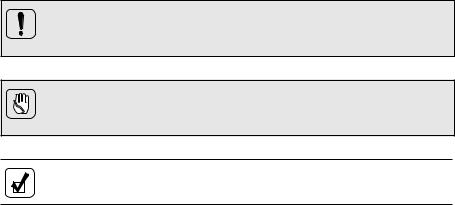
WARNINGS, CAUTIONS, NOTES
IT IS YOUR RESPONSIBILITY to be completely familiar with the warnings and cautions described in this manual. It is, however, important to understand that these warnings and cautions are not exhaustive. Allison Transmission could not possibly know, evaluate, and advise the service trade of all conceivable ways in which service might be done or of the possible hazardous consequences of each way. The vehicle manufacturer is responsible for providing information related to the operation of vehicle systems (including appropriate warnings, cautions, and notes). Consequently, Allison Transmission has not undertaken any such broad evaluation. Accordingly, ANYONE WHO USES A SERVICE PROCEDURE OR TOOL WHICH IS NOT RECOMMENDED BY ALLISON TRANSMISSION OR THE VEHICLE MANUFACTURER MUST first be thoroughly satisfied that neither personal safety nor equipment safety will be jeopardized by the service methods selected.
Proper service and repair is important to the safe, reliable operation of the equipment. The service procedures recommended by Allison Transmission (or the vehicle manufacturer) and described in this manual are effective methods for performing service operations. Some of these service operations require the use of tools specially designed for the purpose. The special tools should be used when and as recommended.
Three types of headings are used in this manual to attract your attention. These warnings and cautions advise of specific methods or actions that can result in personal injury, damage to the equipment, or cause the equipment to become unsafe.
WARNING: A warning is used when an operating procedure, practice, etc., if not correctly followed, could result in personal injury or loss of life.
CAUTION: A caution is used when an operating procedure, practice, etc., if not strictly observed, could result in damage to or destruction of equipment.
NOTE: A note is used when an operating procedure, practice, etc., is essential to highlight.
6

|
INTRODUCTION |
Section I |
|
|
|
1–1. ABOUT THIS MANUAL
This manual is a mechanic’s reference for maintaining, removing, or installing 3000 and 4000 Product Family transmissions with Allison 4th Generation Controls. All features of the transmission and the vehicle involved in installation procedures are discussed. The information presented will help the mechanic maintain, remove, or install the transmission in a manner that assures satisfactory operation and long service life. For additional detailed information, refer to the appropriate transmission service manual and electronic controls troubleshooting manual.
Unless specifically indicated otherwise, this manual refers to all Allison 4th Generation Controls for 3000 and 4000 Product Family transmissions, except for the 3700 SP model. The differences between the various transmission models are explained as required.
7
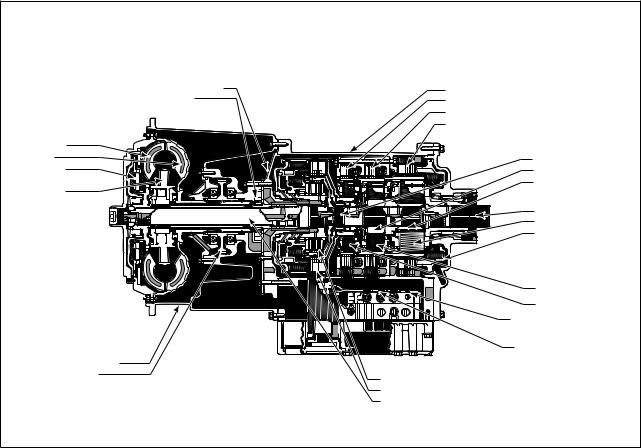
8 |
Transmission Family Product 3000 .1–1 Figure Provision) PTO (With |
|
Section Cross— |
CONVERTER MODULE
•TURBINE
•PUMP
•LOCKUP CLUTCH/DAMPER
•STATOR
FRONT SUPPORT/OIL PUMP MODULE |
MAIN HOUSING MODULE |
• FRONT SUPPORT |
• MAIN HOUSING |
• OIL PUMP |
• C3 CLUTCH |
|
• C4 CLUTCH |
|
• C5 CLUTCH |
MAIN SHAFT MODULE
• MAIN SHAFT
• P2 SUN
• P3 SUN
REAR COVER MODULE |
• OUTPUT SHAFT |
• P3 |
• C5 PISTON |
|
|
P2 MODULE |
|
|
|
P1 MODULE |
|
|
|
OIL LEVEL SENSOR |
|
|
|
CONTROL MODULE |
|
CONVERTER HOUSING MODULE |
|
• ELECTRO-HYDRAULIC |
|
|
CONTROLS |
||
• CONVERTER HOUSING |
ROTATING CLUTCH MODULE |
||
|
|||
• PTO DRIVE GEAR |
|
||
• C1 CLUTCH |
|
||
|
|
||
|
• C2 CLUTCH |
|
|
|
• TURBINE SHAFT |
V03350.06.00 |
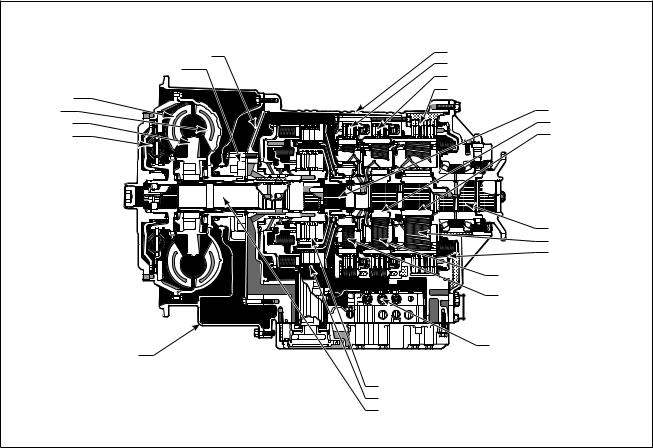
9 |
Family Product 4000 .2–1 Figure |
|
Section Cross—Transmission |
|
FRONT SUPPORT/OIL PUMP MODULE |
MAIN HOUSING MODULE |
|
• MAIN HOUSING |
|
|
• FRONT SUPPORT |
|
|
• C3 CLUTCH |
|
|
• OIL PUMP |
|
|
• C4 CLUTCH |
|
CONVERTER MODULE |
|
|
|
• C5 CLUTCH |
|
• TURBINE |
|
MAIN SHAFT MODULE |
• PUMP |
|
• MAIN SHAFT |
• STATOR |
|
• P2 SUN |
• LOCKUP |
|
• P3 SUN |
• CLUTCH/DAMPER |
|
|
CONVERTER HOUSING MODULE
• CONVERTER HOUSING
REAR COVER MODULE |
• OUTPUT SHAFT |
• P3 MODULE |
• C5 PISTON |
P2 MODULE
P1 MODULE
CONTROL MODULE
• ELECTRO-HYDRAULIC CONTROLS
ROTATING CLUTCH MODULE
•C1 CLUTCH
•C2 CLUTCH
• TURBINE SHAFT |
V07286.01.00 |
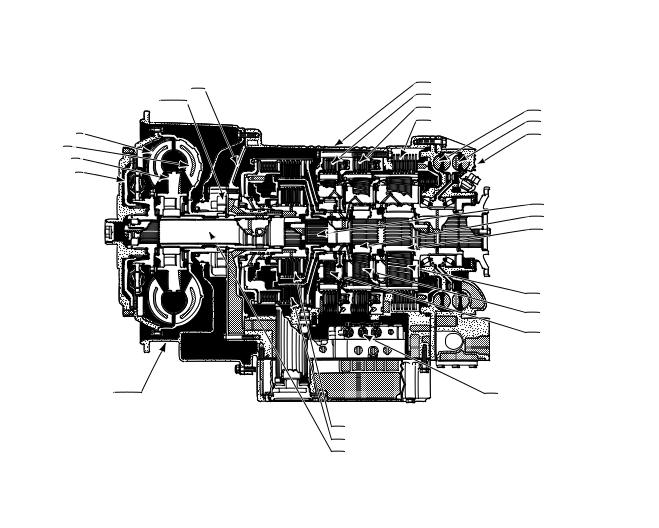
|
Product 4000 .3–1 Figure |
|
(With |
|
Family |
10 |
Retarder) |
|
Section CrossTransmission— |
FRONT SUPPORT/OIL PUMP MODULE |
|
MAIN HOUSING MODULE |
|
||
|
|
• MAIN HOUSING |
|
||
• FRONT SUPPORT |
|
|
|
||
|
|
• C3 CLUTCH |
RETARDER MODULE |
||
• OIL PUMP |
|
|
|||
CONVERTER MODULE |
|
|
• C4 CLUTCH |
• STATOR ASSEMBLY |
|
|
|
• C5 CLUTCH |
• ROTOR |
ASSEMBLY |
|
• TURBINE |
|
|
|
• HOUSING |
|
• PUMP |
|
|
|
|
|
• STATOR |
|
|
|
|
|
• LOCKUP |
|
|
|
|
|
CLUTCH/DAMPER |
|
|
|
MAIN SHAFT |
MODULE |
|
|
|
|
• MAIN SHAFT |
|
|
|
|
|
• P2 SUN |
|
|
|
|
|
• P3 SUN |
|
|
|
|
|
P3 MODULE |
|
|
|
|
|
P2 MODULE |
|
|
|
|
|
P1 MODULE |
|
CONVERTER HOUSING |
|
|
|
CONTROL MODULE |
|
MODULE |
|
|
|
|
|
• CONVERTER |
|
|
|
• ELECTRO-HYDRAULIC |
|
HOUSING |
ROTATING CLUTCH |
MODULE |
CONTROLS |
|
|
|
|
|
|||
|
• C1 CLUTCH |
|
|
|
|
|
• C2 |
CLUTCH |
|
|
|
|
• TURBINE SHAFT |
|
|
V07287.04.00 |
|
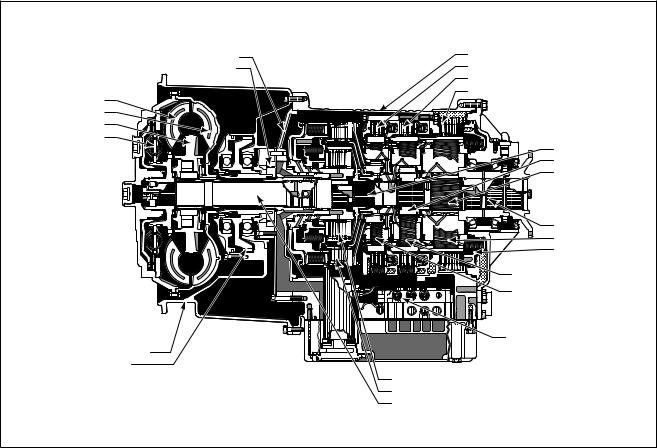
11 |
Transmission Family Product 4000 .4–1 Figure Provision) PTO (With |
|
Section Cross— |
FRONT SUPPORT/OIL PUMP MODULE |
MAIN HOUSING MODULE |
||
• FRONT SUPPORT |
• MAIN HOUSING |
||
• OIL PUMP |
• C3 |
CLUTCH |
|
CONVERTER MODULE |
• C4 |
CLUTCH |
|
• C5 |
CLUTCH |
||
TURBINE |
|||
|
|
||
PUMP |
|
|
|
STATOR |
|
MAIN SHAFT MODULE |
|
LOCKUP |
|
||
CLUTCH/DAMPER |
|
• MAIN SHAFT |
|
|
|
• P2 SUN |
|
|
|
• P3 SUN |
|
REAR COVER MODULE |
• OUTPUT SHAFT |
• P3 MODULE |
• C5 PISTON |
P2 MODULE
P1 MODULE
|
|
CONTROL MODULE |
CONVERTER HOUSING MODULE |
|
• ELECTRO-HYDRAULIC CONTROLS |
• CONVERTER HOUSING |
|
|
• PTO DRIVE GEAR |
ROTATING CLUTCH MODULE |
|
|
||
|
• C1 |
CLUTCH |
|
• C2 |
CLUTCH |
|
• TURBINE SHAFT |
|
|
|
V07288.01.00 |
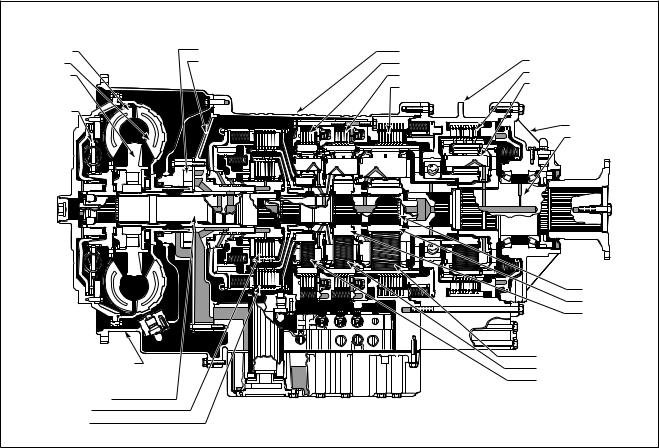
|
|
|
CONVERTER MODULE |
FRONT SUPPORT/OIL PUMP MODULE |
MAIN HOUSING MODULE |
C6 ADAPTER HOUSING |
|
|
|
• TURBINE |
• OIL PUMP |
• MAIN HOUSING |
MODULE |
|
|
|
• PUMP |
• FRONT SUPPORT |
• C3 CLUTCH |
• C6 ADAPTER HOUSING |
|
|
Figure |
• STATOR |
|
• C4 CLUTCH |
• C6 CLUTCH |
|
|
|
• P4 MODULE |
|||
|
|
• LOCKUP |
|
• C5 CLUTCH |
||
|
|
|
|
|||
|
|
CLUTCH/ |
|
|
REAR COVER |
|
|
|
DAMPER |
|
|
||
|
|
|
|
MODULE |
||
|
|
1 |
|
|
||
|
|
|
|
|
• REAR COVER |
|
|
|
.5– |
|
|
|
|
|
|
|
|
|
• OUTPUT SHAFT |
|
|
|
4000 |
|
|
|
|
12 |
Speed)-(7 |
Family Product |
|
|
|
MAIN SHAFT |
|
|
|
MODULE |
|||
|
|
— |
|
|
|
|
|
|
|
|
|
• MAIN SHAFT |
|
|
|
Cross |
|
|
|
|
|
|
|
|
|
• P3 SUN |
|
|
|
|
|
|
• P2 SUN |
|
|
|
CONVERTER |
|
|
|
|
|
|
Section |
|
|
|
|
|
|
HOUSING MODULE |
|
|
P3 MODULE |
|
|
|
• CONVERTER HOUSING |
|
|
||
|
|
|
|
P2 MODULE |
||
|
|
|
|
|
||
|
|
ROTATING CLUTCH MODULE |
|
|
P1 MODULE |
|
|
|
|
|
|
||
|
|
|
|
|
|
|
|
|
|
• TURBINE SHAFT |
|
|
V05641.02.00 |
|
|
|
• C1 CLUTCH |
|
|
|
|
|
|
• C2 CLUTCH |
|
|
|
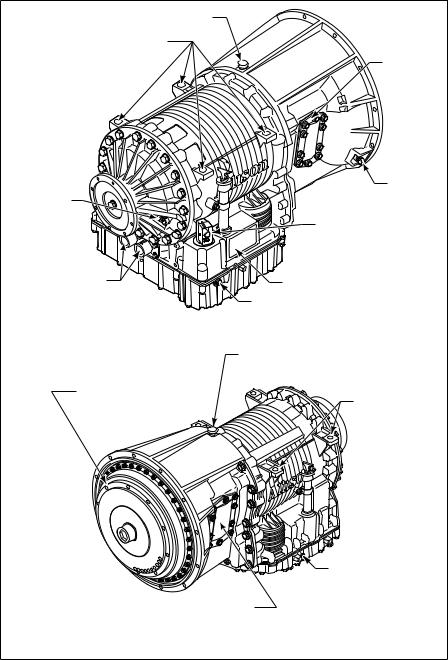
BREATHER |
|
|
ASSEMBLY PADS |
|
|
|
|
PTO |
|
|
PROVISION |
|
|
INPUT |
OUTPUT |
|
SPEED |
|
SENSOR |
|
SPEED |
|
|
|
|
|
SENSOR |
|
FEEDTHROUGH HARNESS |
|
|
CONNECTOR |
COOLER PORTS |
NAMEPLATE |
|
NOTE: Inch Series Threads |
MAIN-PRESSURE TAP |
|
|
||
|
NOTE: Inch Series Threads |
|
RIGHT-REAR VIEW |
|
|
BREATHER |
|
|
TORQUE CONVERTER |
|
|
WITH LOCKUP CLUTCH |
|
ASSEMBLY PADS |
AND TORSIONAL DAMPER |
|
(BOTH SIDES) |
|
|
MAIN-PRESSURE TAP |
|
|
NOTE: Inch Series Threads |
PTO PROVISION |
|
|
(AVAILABLE BOTH SIDES) |
|
|
LEFT-FRONT VIEW |
V07289.01.00 |
|
Figure 1–6. 3000 Product Family
(With PTO Provision)
13
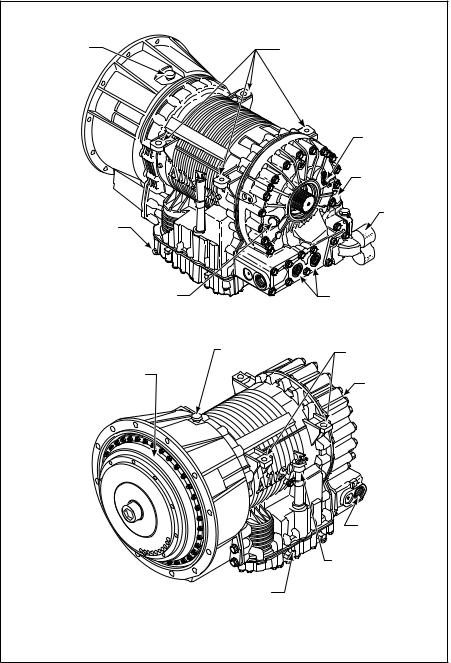
BREATHER |
ASSEMBLY PADS |
|
OUTPUT |
|
|
SPEED |
|
|
SENSOR |
|
|
RETARDER |
|
|
VALVE BODY |
|
|
CONNECTOR |
|
|
SUMP |
|
MAIN-PRESSURE TAP |
COOLER |
|
PROVISION |
||
NOTE: Inch Series Threads |
||
|
||
TACHOGRAPH PROVISION |
COOLER PORTS |
|
NOTE: Metric Series Threads |
NOTE: Inch Series Threads |
|
|
|
|
BREATHER |
ASSEMBLY PADS |
|
|
||
TORQUE CONVERTER |
(BOTH SIDES) |
|
|
||
WITH LOCKUP CLUTCH |
OUTPUT |
|
AND TORSIONAL DAMPER |
RETARDER |
|
TO RETARDER |
|
ACCUMULATOR |
|
OIL FILL TUBE AND |
|
DIPSTICK |
MAIN-PRESSURE TAP |
(AVAILABLE ON |
BOTH SIDES) |
|
NOTE: Inch series threads |
|
|
V07401.01.00 |
Figure 1–7. 3000 Product Family
(With Retarder)
14
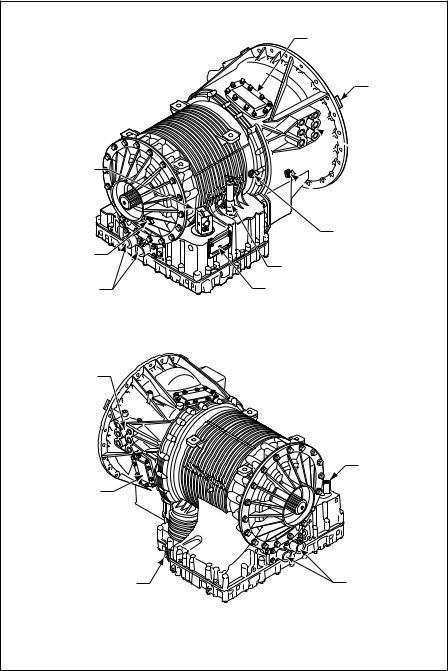
PTO
(TOP RIGHT POSITION)
FEEDTHROUGH HARNESS CONNECTOR
OUTPUT SPEED SENSOR
COOLER PORTS
SHIPPING
BRACKET (3)
 MOUNTING
MOUNTING
PAD
 ENGINE SPEED
ENGINE SPEED
SENSOR
TURBINE SPEED
SENSOR
FILL TUBE
NAMEPLATE
MOUNTING PAD (BOTH SIDES)
|
FEEDTHROUGH |
|
HARNESS |
PTO |
CONNECTOR |
|
|
(BOTTOM LEFT |
|
POSITION) |
|
MAIN-PRESSURE TAP |
COOLER PORTS |
V07291.01.00
Figure 1–8. 4000 Product Family
(With PTO Provision)
15
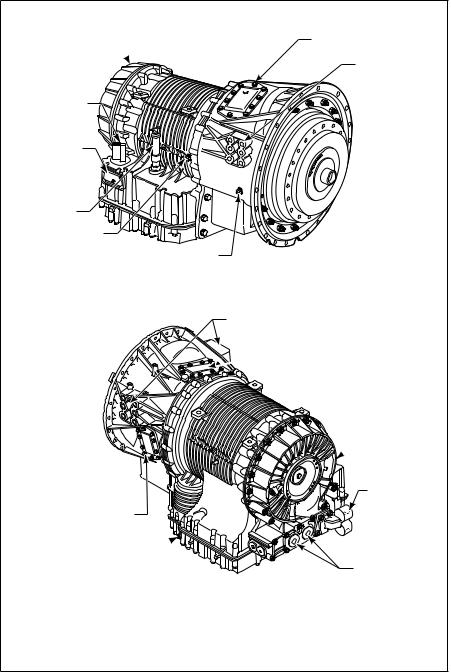
RETARDER
FEEDTHROUGH
HARNESS
CONNECTOR
NAMEPLATE |
FILL TUBE
TURBINE
SPEED SENSOR
ENGINE SPEED SENSOR
PTO (TOP RIGHT POSITION)
MOUNTING PADS (BOTH SIDES)
PTO (BOTTOM LEFT
POSITION)
MAIN-PRESSURE TAP
MOUNTING PADS (BOTH SIDES)
 PTO (TOP RIGHT POSITION)
PTO (TOP RIGHT POSITION)
 RETARDER
RETARDER
SUMP
COOLER
PROVISION
COOLER PORTS |
V07292.01.00
Figure 1–9. 4000 Product Family
(With Retarder and PTO Provision)
16
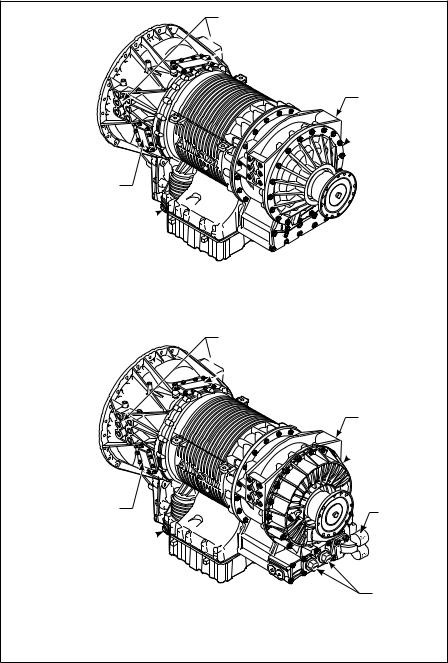
MOUNTING PADS (BOTH SIDES)
 PTO (TOP RIGHT POSITION)
PTO (TOP RIGHT POSITION)
C6 ADAPTER
HOUSING
 REAR COVER
REAR COVER
PTO (BOTTOM LEFT
POSITION)
MAIN-PRESSURE TAP
PTO (BOTTOM LEFT
POSITION)
MAIN-PRESSURE TAP
MOUNTING PADS (BOTH SIDES)
 PTO (TOP RIGHT POSITION)
PTO (TOP RIGHT POSITION)
C6 ADAPTER
HOUSING
 RETARDER
RETARDER
SUMP
COOLER
PROVISION
COOLER |
PORTS |
V07399.01.00
Figure 1–10. 4000 Product Family
(7-Speed)
17
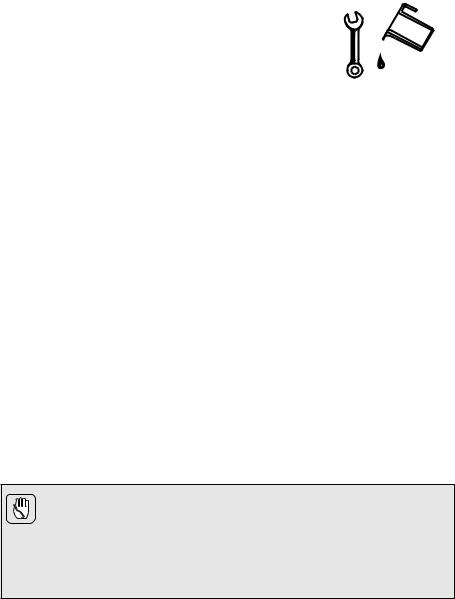
Section II |
PREVENTIVE |
|
MAINTENANCE |
|
|
|
|
|
|
|
|
2–1. PERIODIC INSPECTION AND CARE
a.Transmission Inspection. Clean and inspect the exterior of the transmission at regular intervals. Severity of service and operating conditions determine the frequency of these inspections. Inspect the transmission for:
•Loose bolts—transmission and mounting components.
•Fluid leaks—repair immediately.
•Loose, dirty, or improperly adjusted throttle sensor.
•Damaged or loose hoses.
•Worn, frayed, or improperly routed electrical harnesses.
•Worn or damaged electrical connectors.
•Dented, worn or out-of-phase driveline U-joints and slip fittings.
•Clogged or dirty breather (vent assembly).
•Check transmission fluid for evidence of engine coolant.
b.Vehicle Inspection. Check the vehicle cooling system occasionally for evidence of transmission fluid. Transmission fluid in the vehicle cooling system indicates a faulty oil cooler.
c.Welding.
CAUTION: When welding on the vehicle:
• DO NOT WELD on the vehicle without disconnecting from the TCM all control system wiring harness connectors.
•DO NOT WELD on the vehicle without disconnecting TCM battery power and ground leads.
•DO NOT WELD on any control components.
•DO NOT CONNECT welding cables to any control components.
A label describing on-vehicle welding precautions (ST2067EN) is available from your authorized Allison service dealer and should be installed in a conspicuous place. A vehicle used in a vocation that requires frequent modifications or repairs involving welding must have an on-vehicle welding label.
18
2–2. IMPORTANCE OF PROPER TRANSMISSION FLUID LEVEL
Transmission fluid cools, lubricates, and transmits hydraulic power. Always maintain proper fluid level. If fluid level is too low, the torque converter and clutches do not receive an adequate supply of fluid and the transmission overheats. If the level is too high, the fluid aerates—causing the transmission to shift erratically and overheat. Fluid may be expelled through the breather or dipstick tube when the fluid level is too high.
2–3. TRANSMISSION FLUID CHECK
a. Electronic Fluid Check Procedure. Fluid level can be electronically displayed when the transmission contains the optional oil level sensor (OLS). Fluid level can be displayed on the shift selector or Allison DOC™. However, no oil level sensor diagnostics take place unless the OLS is “autodetected” by the Allison 4th Generation control system. Frequently check for the presence of oil level diagnostics if the transmission is known to contain an OLS. If an OLS is not detected during the first 49 engine starts, the control system concludes that no OLS is present. If an OLS is known to be present, but has not been detected, then troubleshoot the OLS circuit. After the OLS circuit is repaired, reset “autodetect” (refer to TS3989EN, Allison 4th Generation Controls Troubleshooting Manual for detailed troubleshooting procedures).
•Displaying Fluid Level Information. Use the following procedure to display fluid level information.
—For a pushbutton shift selector: Simultaneously press the ↑ (Up) and ↓ (Down) arrow buttons once.
—For a lever shift selector: Press the DISPLAY MODE button once.
—For the Allison DOC™ diagnostic tool: Refer to the Allison DOC™ User Guide.
•Fluid Level Display Criteria. As soon as fluid level information is requested, the TCM checks to see if conditions are right to allow display. Certain operating conditions must have been met for a period of two minutes before fluid level is displayed. These operating conditions are:
—Engine at idle
—Sump fluid temperature at 60–104°C (140–220°F)
—Transmission output shaft stopped
—Transmission in N (Neutral)
—Oil level sensor functioning properly
19

NOTE: To optimize the accuracy of the electronic fluid level measurement, be sure sump temperature is in the normal operating range of 71–93°C (160–200°F).
If the two minute period has elapsed before the fluid level data request, information is displayed immediately. However, if the two minute period has not elapsed, there will be a countdown display before fluid level information displays. The countdown display flashes constantly on the monitor digit. Countdown starts at 8 and decreases sequentially to 1 during the two minute period. When fluid level data is requested, and the two minute countdown is in process, the flashing display shows the number corresponding to the countdown progress. For example—if the fluid level data was requested in the middle of the two minute countdown period, the display would flash a 5 or a 4 and decrease to 1.
•Shift Selector Display. Fluid level information is displayed two characters at a time as in Table 2–1:
Table 2–1. Fluid Level Shift Selector Display
Display Sequence |
Interpretation of Display |
oL oK |
Fluid level is correct |
oL Lo 01 |
Fluid level is 1 quart low |
oL HI 01 |
Fluid level is 1 quart high |
The shift selector display will also show “invalid for display” codes two characters at a time. An “invalid for display” code is returned when fluid level data is requested, but an operational condition has not been met. The “invalid for display” condition interrupts the two minute countdown (momentary increase in engine speed does not affect the countdown). The “invalid for display” codes and their meaning are:
Table 2–2. Invalid For Display Codes
Display Sequence |
Interpretation of Display |
oL–50 |
Engine rpm too low |
oL–59 |
Engine rpm too high |
oL–65 |
N (Neutral) not selected |
oL–70 |
Sump fluid temperature too low |
oL–79 |
Sump fluid temperature too high |
oL–89 |
Output shaft rotation |
oL–95 |
Sensor failure |
20
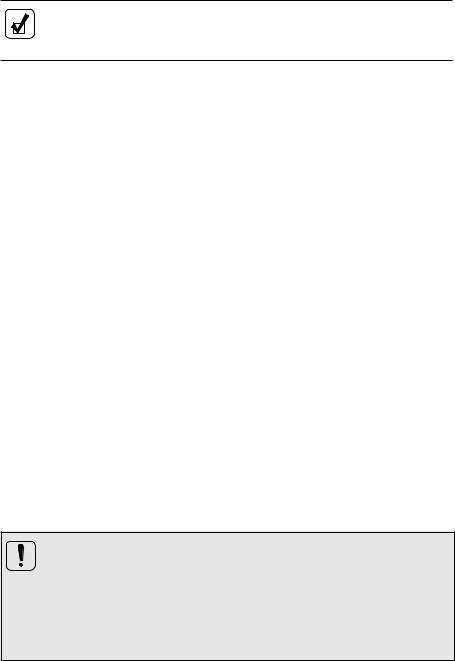
NOTE: Report sensor failure to a distributor or dealer in your area. Consult the telephone directory for the Allison Transmission distributor or dealer near you.
The countdown is restarted when the condition causing the “invalid for display” code is corrected. The countdown is not restarted if there is a momentary increase in engine rpm which may generate a code 59. “Invalid for display” messages are as follows:
•On Allison diagnostic tools, “Invalid for display” messages are shown in the Oil (±) field of the Data Monitor.
Table 2–3. Invalid for Display Messages
DDR Message
OL — SETTLING TIME X
OL — ENGINE SPEED LO
OL — ENGINE SPEED HI
OL — SELECT N (NEUTRAL)
OL — SUMP TEMP LO
OL — SUMP TEMP HI
OL — OUTPUT SPEED HI
OL — CHECK CODES
•Exiting the Fluid Level Mode. Exit as follows:
—For a pushbutton shift selector, press the N (Neutral) pushbutton once.
—For a lever selector, press the MODE button once or move the lever.
—For Allison DOC™, follow directions in the Allison DOC™ User Guide.
b.Manual Fluid Check Procedure.
WARNING: To help avoid personal injury or property damage caused by sudden and unexpected vehicle movement, do not check the fluid level until you:
1.Put the transmission in N (Neutral).
2.Apply the parking brake and emergency brakes and make sure they are properly engaged.
3.Chock the wheels and take any other steps necessary to keep the vehicle from moving.
Clean all dirt from around the end of the fluid fill tube before removing the dipstick. Do not allow dirt or foreign matter to enter the transmission. Dirt or
21
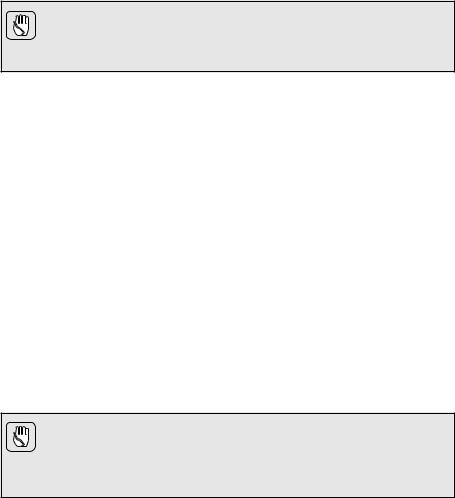
foreign matter in the hydraulic system may cause undue wear of transmission parts, make valves stick, and clog passages. Check the fluid level using the following procedure and report any abnormal fluid levels to your service management.
c. Cold Check Procedure. The purpose of the cold check is to determine if the transmission has enough fluid to be operated safely until a hot check can be made.
CAUTION: The fluid level rises as fluid temperature rises. DO NOT fill above the “COLD CHECK” band if the transmission fluid is below normal operating temperatures. During operation, an overfull transmission can become overheated, leading to transmission damage.
1.Park the vehicle on a level surface. Apply the parking brake and chock the wheels.
2.Run the engine for at least one minute. Shift to D (Drive), then to N (Neutral), and then to R (Reverse) to fill the hydraulic system.
3.Shift to N (Neutral) and allow the engine to idle (500–800 rpm).
4.With the engine running, remove the dipstick from the tube and wipe the dipstick clean.
5.Insert the dipstick into the tube until it stops and remove. Check the fluid level reading. Repeat the check procedure to verify the reading.
6.If the fluid level is within the “COLD CHECK” band, the transmission may be operated until the fluid is hot enough to perform a “HOT RUN” check. If the fluid level is not within the “COLD CHECK” band, add or drain as necessary to bring it to the middle of the “COLD CHECK” band.
7.Perform a hot check at the first opportunity after the normal operating sump temperature of 71°C–93°C (160°F–200°F) is reached.
d.Hot Check Procedure.
CAUTION: When performing the Hot Check procedure, the fluid must be at operating temperature to be sure of an accurate check and help prevent transmission damage. The fluid level rises as temperature increases. During operation, an overfull transmission can become overheated leading to transmission damage.
1.Operate the transmission in D (Drive) until normal operating temperatures are reached:
•Sump temperature 71°C–93°C (160°F–200°F)
•Converter-out temperature 82°C–104°C (180°F–220°F)
22

•If the transmission temperature gauge is not present, check fluid level when the engine water temperature gauge has stabilized and the transmission has been operated under load for at least one hour.
2.Park the vehicle on a level surface and shift to N (Neutral). Apply the parking brake and chock the wheels. Allow the engine to idle (500–800 rpm).
3.With the engine running, remove the dipstick from the tube and wipe clean.
4.Insert the dipstick into the tube until it stops. Then remove it. Check fluid level reading.
5.Repeat the check procedure to verify the reading.
NOTE: Safe operating level is within the “HOT RUN” band on the dipstick. The “HOT RUN” band is between the “HOT FULL” and the “HOT ADD” bands. Refer to Figure 2–1.
6.If the fluid level is not within the “HOT RUN” band, add or drain as necessary to bring the fluid level to within the “HOT RUN” band.
23
